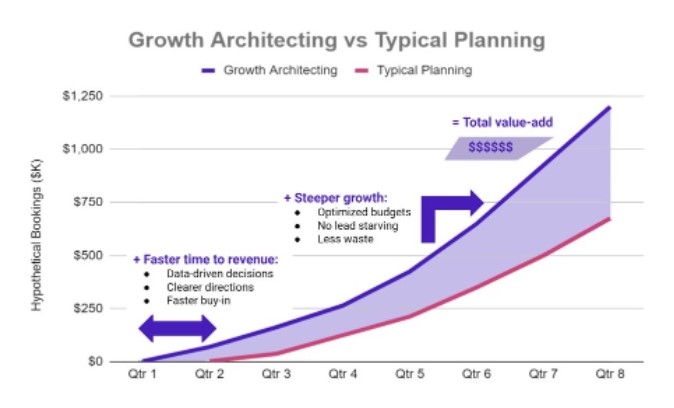Path to Faster Revenue Attainment – And Steeper Revenue Ramps
If you want to know how your marketing and demand gen teams performed last quarter, you’re in luck. There’s a slew of marketing and revenue analytics tools geared at measuring historical lead generation and conversion rates and attributing past revenue to lead sources.
But if you’re the CEO of a small to medium-sized tech startup, your true objective is to minimize your time to future revenue – and last quarter’s metrics alone aren’t going to get you there. Sure, historical performance can offer lessons in how to optimize going forward – but, for the most part, the past is the past, especially if the underlying data is insufficient or of low quality. The key to faster and greater revenue lies not in recapping last quarter but in accurately forecasting achievable performance for the rest of the year. That’s what the Board wants. That’s how you identify the resources necessary to hit your number. That’s how you win.
And what tools do today’s CEOs use for their forward-looking objectives? Little more than homegrown spreadsheets full of numbers, distributed across various computers in their companies. Between the CFO’s company model, the CRO’s bottom-up forecast or quota capacity model, the CMO’s marketing metrics, Revenue Operations’ pipeline calculations, and the CEO’s own model, there often are five or more spreadsheets … that don’t talk to each other and that often are based on different assumptions that can’t model the complexities of a company’s growth. And trying to cascade a coordinated set of changes through these disconnected spreadsheets takes days or weeks to ensure everyone is in sync – if ever.
It’s long past time to shift from backward-facing marketing analytics tools or simple, disconnected spreadsheets to forward-looking “Growth ArchitectingTM”. This means investing in planning tools and approaches built to produce reliable company growth plans, enabling CEOs and CROs to actually succeed in their jobs without having to report to the board at the end of the quarter being on the defensive (for a deeper analysis of these risks, see our recent blog, “Are you missing your number or is someone over-forecasting?”). By making these shifts, C-level leaders can accomplish two things:
- Faster time to revenue – They’ll have the data-driven plan they need to start producing revenue sooner.
- A steeper ramp – Not only will the money come in faster, there will be more and more of it as time goes on.

Legacy tools aren’t actually that bad…are they?
We get it: Change doesn’t always come easy in business – especially when you’re locked into a subscription deal with a SaaS vendor for the next seven months. But the longer CEOs put their forecasts in the hands of legacy tools that haven’t changed with the times, the more they – not to mention their investors – are going to be disappointed.
Here’s where existing tools fall short.
Marketing analytics
Again, marketing analytics tools are great for recapping the past (if the date they contain is accurate and timely). But the only forward-looking value-add they provide is trial and error – if your data shows that you fell short last quarter, for example, then you know to try something different next time.
By the time you can process these trial-and-error insights and turn them into an improvement plan, however, it’s too late to actually yield any benefits in a preventive manner – next quarter is already off to the races. No tech CEO with a hungry board of investors has time for that.
Homegrown spreadsheets
What can tactfully be said about attempts to use spreadsheets, a product category first released in the 1980s, to make accurate sales forecasts in 2022? Homegrown, disconnected spreadsheets lack the functionality to seamlessly optimize for different budgets and other key variables. They don’t exactly make it easy to map out detailed, upstream KPIs. Owing to these factors and others, they’re prone to overprediction, meaning more missed goals, more uncomfortable conversations, and more lost jobs.
Faster and steeper revenue production with Growth Architecting
The core difference between Growth Architecting technology and legacy systems comes down to this: Growth Architecting tools are actually designed for accurately planning growth within a modern annual-recurring-revenue business model. These tools are forward-looking rather than backward-looking, and they don’t require you to try to bend a simple – and, let’s be honest, ancient – spreadsheet tool to your specific, high-stakes needs. They’re built upon the reality that tech executives need to be able to define lead flows, account for key variables, and make data-supported adjustments on the fly if they hope to set a realistic revenue goal and actually hit it.
Shifting to Growth Architecting means investing in tools and resources to level-up your revenue planning – and your successful revenue attainment. It means accelerating your time to revenue through data-driven decision making, clearer direction, and faster buy-in from key stakeholders. It means steepening the upward curve of your closed-won sales chart by optimizing your budgets, eliminating lead starving, and reducing waste. Once these pieces are in place, you’ll be in a position to stroll into your next board meeting not on the defensive, but with a confident smile on your face.








